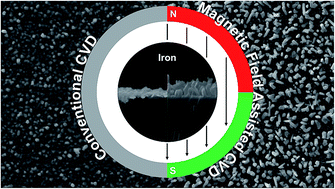Anisotropy control in magnetic nanostructures through field-assisted chemical vapor deposition†
Abstract
Chemical vapor deposition of iron pentacarbonyl (Fe(CO)5) in an external magnetic field (B = 1.00 T) was found to significantly affect the microstructure and anisotropy of as-deposited iron crystallites that could be transformed into anisotropic hematite (α-Fe2O3) nanorods by aerobic oxidation. The deterministic influence of external magnetic fields on CVD deposits was found to be substrate-independent as demonstrated by the growth of anisotropic α-Fe columns on FTO (F:SnO2) and Si (100), whereas the films deposited in the absence of the magnetic field were constituted by isotropic grains. TEM images revealed gradual increase in average crystallite size in correlation to the increasing field strength and orientation, which indicates the potential of magnetic field-assisted chemical vapor deposition (mfCVD) in controlling the texture of the CVD grown thin films. Given the facet-dependent activity of hematite in forming surface-oxygenated intermediates, exposure of crystalline facets and planes with high atomic density and electron mobilities is crucial for oxygen evolution reactions. The field-induced anisotropy in iron nanocolumns acting as templates for growing textured hematite pillars resulted in two-fold higher photoelectrochemical efficiency for hematite films grown under external magnetic fields (J = 0.050 mA cm−2), when compared to films grown in zero field (J = 0.027 mA cm−2). The dark current measurements indicated faster surface kinetics as the origin of the increased catalytic activity.



 Please wait while we load your content...
Please wait while we load your content...